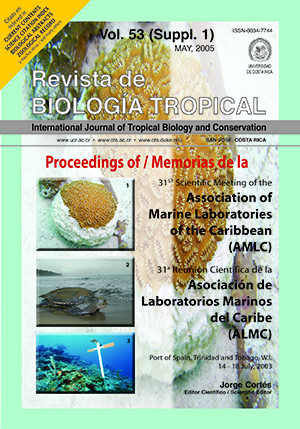Abstract
This fishery was examined utilizing public records, stakeholder interviews, and operational site visits to describe the fishery for the Puerto Rico Coral Reef Advisory Committee as a first step toward development of policies for the effective management of these natural resources. The fishery is not large, including fewer than 20 licensed fishers operating primarily on the west end of the island. Only three operators export product, with the remaining fishers providing specimens to the exporters based upon customer orders. Most collection of coral reef species occurs over hard rubble zones mixed with relic reef structures and rock, or on the sides and frontal areas of active reefs. Other species are collected from among mangrove prop root zones, tidal flats, and seagrass beds. Collections are made using simple barrier and dip nets for fish and motile invertebrates such as shrimp. Invertebrates such as crabs, starfish, and sea cucumbers are commonly collected by overturning small rocks, gathering the specimens, and then replacing the rocks in their original positions. Specimens are carried to the boat and transferred to individual cup holders to maximize survival. Although statements concerning former use of chemicals to assist capture were noted, no evidence of current chemical use was observed. Specimens are held in re-circulating seawater systems onshore until collections are aggregated and shipped. The fishery strives to operate with mortality of <1%, as mortalities of >3% are described as unacceptable to customers. More than 100 fish species are collected in this fishery, but the top ten species account for >70% of the total numbers and >60% of the total value of the fishery, with a single species, Gramma loreto (Royal Gramma), comprising >40% of the numbers. More than 100 species of invertebrates are collected, but this fishery is also dominated by a handful of species, including anemones, hermit crabs, turbo snails, serpent starfish, and feather duster polychaetes.References
Barber, C.V. & V.R. Pratt. 1998. Policy reform and community- based programs to combat cyanide fishing in the Asia-Pacific region, p. 39-49. In M.E. Hatziolos and M. Fodor (eds.). Proceedings of the conference on “Coral reefs: challenges and opportunities for sustainable management”. The World Bank. Washington, DC, Oct. 9-11, 1997.
Hardin, M.P. & R.S. LeGore. 2005. Development of management policy for the export fishery for marine ornamental fish and invertebrates in Puerto Rico. Proc. 31st AMLC Scient. Meet., Trinidad & Tobago. Rev. Biol. Trop. 53 (Suppl. 1): in press.
Ojeda-Serrano, E., A. Aguilar-Perera & D. Matos-Caraballo. 2001. Current status of the wild marine ornamental fish trade in Puerto Rico, p. 109. In Proceedings: Second conference on marine ornamentals: collection, culture, and conservation. Nov. 26-Dec. 1, 2001. Lake Buena Vista, Florida, USA.
Comments

This work is licensed under a Creative Commons Attribution 4.0 International License.
Copyright (c) 2005 Revista de Biología Tropical






